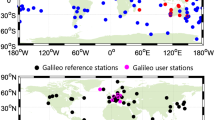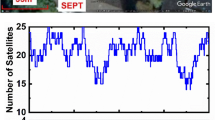Abstract
Triple-frequency signals have thus far been available for all satellites of BeiDou and Galileo systems and for some GPS satellites. The main benefit of triple-frequency signals is their formation of extra-wide-lane (EWL) combinations whose ambiguities can be instantaneously fixed for several 10–100 km baselines. Yet, this benefit has not been fully exploited and only used as a constraint for narrow-lane (NL) ambiguity resolution (AR) in most previous studies. In this study, we comprehensively investigate the real-time kinematic (RTK) capabilities of EWL observations, also referred to as EWL RTK (ERTK). We begin by mathematically expressing the ease of EWL AR and the difficulty of NL AR, respectively, using a numerical demonstration. We then present the mathematical models for ERTK including the ionosphere-ignored, ionosphere-float and ionosphere-smoothed types. The experiments are conducted using a four-station network of real triple-frequency BeiDou data with baseline lengths from 33 to 75 km. The results show that the ionosphere-ignored ERTK achieves real-time solutions with a horizontal accuracy of about 10 cm. Although the ionosphere-float ERTK solutions are very noisy, they can be quickly improved at the centimetre level by further applying the ionosphere-smoothed model. Note that such accurate results are very promising and already satisfy many applications without complicated NL AR. To the best of our knowledge, this is the first comprehensive study to make full use of EWL observations of triple-frequency signals on RTK.











Similar content being viewed by others
References
Chen X, Vollath U, Landau H (2004) Will GALILEO/modernized GPS obsolete network RTK. In: ENC-GNSS 2004, Rotterdam, Netherlands
Cocard M, Bourgon S, Kamali O, Collins P (2008) A systematic investigation of optimal carrier-phase combinations for modernized triple-frequency GPS. J Geod 82(9):555–564
Collins J, Langley B (1997) A tropospheric delay model for the user of the wide area augmentation system. Tech. Rep. No. 187, Department of Geodesy and Geomatics Engineering, University of New Brunswick
Dai L, Eslinger D, Sharpe T (2007) Innovative algorithms to improve long range RTK reliability and availability. In: Proceedings of ION NTM 2007, San Diego CA, pp 860–872
deLacy MC, Reguzzoni M, Sansò F (2012) Real-time cycle slip detection in triple-frequency GNSS. GPS Solut 16(3):353–362
Feng Y (2008) GNSS three carrier ambiguity resolution using ionosphere-reduced virtual signals. J Geod 82(12):847–862
Feng Y, Li B (2008) A benefit of multiple carrier GNSS signals: regional scale network-based RTK with doubled inter-station distances. J Spat Sci 53:135–147
Feng Y, Li B (2010) Wide area real time kinematic decimetre positioning with multiple carrier GNSS signals. SCIENCE CHINA Earth Sci 53(5):731–740
Fernández-Plazaola U, Martín-Guerrero TM, Entrambasaguas JT (2008) A new method for three-carrier GNSS ambiguity resolution. J Geod 82(4–5):269–278
Geng J, Bock Y (2013) Triple-frequency GPS precise point positioning with rapid ambiguity resolution. J Geod 87(5):449–460
Gu S, Lou Y, Shi C, Liu J (2015) BeiDou phase bias estimation and its application in precise point positioning with triple-frequency observable. J Geod 89(10):979–992
Guo F, Zhang X, Wang J, Ren X (2016) Modeling and assessment of triple-frequency BDS precise point positioning. J Geod 90(11):1223–1235
Hatch R (1982) The Synergism of GPS code and carrier measurements. In: The 3rd international geodetic symposium on satellite doppler positioning, Vol 2. Las Cruces-New Mexico, pp 1213–1231
Hatch R, Jung J, Enge P (2000) Civilian GPS: the benefits of three frequencies. GPS Solut 3(4):1–9
He H, Li J, Yang Y, Xu J, Guo H, Wang A (2014) Performance assessment of single- and dual-frequency BeiDou/GPS single-epoch kinematic positioning. GPS Solut 18(3):393–403
Henkel P, Günther C (2012) Reliable integer ambiguity resolution: multi-frequency code carrier linear combinations and statistical a priori knowledge of attitude. J Inst Nav 59(1):61–75
Hou Y, Verhagen S, Wu J (2016) A data driven partial ambiguity resolution: two step success rate criterion, and its simulation demonstration. Adv Space Res 58(11):2435–2452
Leick A, Rapoport L, Tatarnikov M (2015) GPS Satellite Surveying-Fourth Edition. Wiley, New York
Li B, Feng Y, Gao W, Li Z (2015) Real-time kinematic positioning over long baselines using triple-frequency BeiDou signals. IEEE Trans Aerosp Electr Syst 51(4):3254–3269
Li B, Feng Y, Shen Y (2010a) Three carrier ambiguity resolution: distance-independent performance demonstrated using semi-generated triple frequency GPS signals. GPS Solut 14(2):177–184
Li B, Feng Y, Shen Y, Wang C (2010b) Geometry-specified troposphere decorrelation for subcentimeter real-time kinematic solutions over long baselines. J Geophys Res 115:B11404. doi:10.1029/2010JB007549
Li B, Shen Y, Zhang X (2013) Three frequency GNSS navigation prospect demonstrated with semi-simulated data. Adv Space Res 51(7):1175–1185
Li B, Teunissen PJG (2014) GNSS antenna array-aided CORS ambiguity resolution. J Geod 88(4):363–376
Li B, Zhang L, Verhagen S (2017) Impacts of BeiDou stochastic model on reliability: overall test, w-test and minimal detectable bias. GPS Solut. doi:10.1007/s10291-016-0596-z
Odolinski R, Teunissen PJG, Odijk D (2013) An analysis of combined COMPASS/BeiDou-2 and GPS single- and multiple-frequency RTK positioning. In: Proceedings of the ION 2013 Pacific PNT Meeting, Honolulu, HI, April 23–25, 2013, pp 69–90
Odolinski R, Teunissen PJG, Odijk D (2015) Combined BDS, Galileo, QZSS and GPS single-frequency RTK. GPS Solut 19(1):151–163
Parkins A (2011) Increasing GNSS RTK availability with a new single-epoch batch partial ambiguity resolution algorithm. GPS Solut 15:391–402
Richert T, El-Sheimy N (2007) Optimal linear combinations of triple frequency carrier phase data from future global navigation satellite systems. GPS Solut 11(1):11–19
Shi C, Zhao Q, Hu Z, Liu J (2013) Precise relative positioning using real tracking data from COMPASS GEO and IGSO satellites. GPS Solut 17(1):103–119
Spit J (2011) Total electron content reconstruction using triple frequency GNSS signals. Ph.D. thesis, University of Liege
Takasu T, Yasuda A (2010) Kalman-filter-based integer ambiguity resolution strategy for long-baseline RTK with ionosphere and troposphere estimation. ION GNSS 2010. Portland, Oregon, pp 201–207
Teunissen PJG (1995) The least-squares ambiguity decorrelation adjustment: a method for fast GPS integer ambiguity estimation. J Geod 70:65–82
Teunissen PJG (2001) Integer estimation in the presence of biases. J Geod 75(7–8):399–407
Teunissen PJG, Joosten P, Tiberius CCJM (1999) Geometry-free ambiguity success rates in case of partial fixing. National Technical Meeting of ION GNSS-99. San Diego, CA, pp 201–207
Teunissen PJG, Joosten P, Tiberius CCJM (2002) A comparison of TCAR, CIR and LAMBDA GNSS ambiguity resolution. In: ION GPS 2002, Portland, OR, pp 2799–2808
Verhagen S, Li B, Teunissen PJG (2013) Ps-LAMBDA: ambiguity success rate evaluation software for interferometric applications. Comput Geosci 54:361–376
Vollath U, Birnbach S, Landau H (1998) Analysis of three carrier ambiguity resolution (TCAR) technique for precise relative positioning in GNSS-2. ION GPS 1998:417–426
Wang K, Rothacher M (2013) Ambiguity resolution for triple-frequency geometry-free and ionosphere-free combination tested with real data. J Geod 87(6):539–553
Weber R, Karabatic A (2009) Potential improvements in GNSS-based troposphere monitoring by use of upcoming GALILEO signals. In: Proceedings 2nd colloquium-scientific and fundamental aspects of the Galileo program
Wu X, Zhou J, Wang G, Hu X, Cao Y (2012) Multipath error detection and correction for GEO/IGSO satellites. SCIENCE CHINA: Phys Mech Astron 55(7):1297–1306
Zhang X, He X (2016) Performance analysis of triple-frequency ambiguity resolution with BeiDou observations. GPS Solut 20(2):269–281
Zhang X, Li P (2016) Benefits of the third frequency signal on cycle slip correction. GPS Solut 20(3):451–460
Acknowledgements
This work is supported by the National Natural Science Funds of China (41622401, 41574023, 41374031), the State Key Laboratory of Geodesy and Earth’s Dynamics (Institute of Geodesy and Geophysics, CAS) (SKLGED2016-3-1-EZ) and the National Key Research and Development Program of China (2016YFB0501802).
Author information
Authors and Affiliations
Corresponding author
Rights and permissions
About this article
Cite this article
Li, B., Li, Z., Zhang, Z. et al. ERTK: extra-wide-lane RTK of triple-frequency GNSS signals. J Geod 91, 1031–1047 (2017). https://doi.org/10.1007/s00190-017-1006-1
Received:
Accepted:
Published:
Issue Date:
DOI: https://doi.org/10.1007/s00190-017-1006-1




